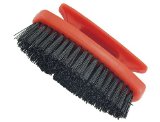How can I dye a white- or clear-bristle fingernail brush so that the bristles are easier to spot when they fall out?
Name: HAL
Country or region: CALIFORNIA USA
Message: I have a black bristle fingernail brush. The bristles are beginning to come out. They are easy to spot in the sink or shower and pick up so they don't go down the drain. How can I dye a white or clear bristle brush to be able to spot them so they don't go down the drain? I will appreciate any suggestions you may have to solve this.
Your white or clear fingernail brush probably has bristles made of nylon. Dyeing nylon is not difficult. Nylon is best dyed by heating it in water with acid dyes. As the name of the dye class suggests, this is to be done in combination with a mild acid, such as white vinegar. (D0n't use an aluminum pot when heating vinegar or any other acid.)
Some acid dyes will last longer in the nylon than others. The acid dye in a Rit All-Purpose dye mixture will work on nylon (the cotton dye also contained in Rit dye will do nothing to nylon), though it will tend to wash out more quickly than other types of acid dye. It's worth trying, because it will probably last well enough for your purpose, and then, if it washes out too quickly, you could look for a longer-lasting dye to try again. Rit all-purpose dye can usually be found in a local grocery store or craft or sewing store. As always with Rit all-purpose dye, the color you get may be rather different from the color predicted on the outside of the box, perhaps a dark green or purple, when you expect to get black.
If the Rit all-purpose dye works but you want a longer-lasting dye, and if you would prefer black, I would recommend you order a dye called Washfast Jet Black WF672, which is Colour Index Acid Black 172, from PRO Chemical & Dye, as it is a particularly wash-resistant acid dye. This dye produces a reliable dark black, assuming you use enough dye powder. Then again, if you are going to go to the trouble of ordering online, you could probably find and order a black-bristled fingernail brush, instead.
If Rit all-purpose dye does not color a fingernail brush's bristles, even temporarily, that would be a sign that the bristles are made of an undyeable polymer. A few fingernail brushes are made with polypropylene bristles, which cannot be dyed at all; colored polypropylene has pigment added in the manufacturing process, while the polymer is still liquid.
Assuming that your bristles are made of nylon, my one concern is how the bristles are held in the brush. I don't know how this is done. If they are held in with a heat-sensitive adhesive--that is, hot glue--then bristles will fall out when you heat the brush, in your mixture of water, dye, and vinegar. If they are held in another way, then there will be no problem. The nylon itself should tolerate temperatures up to a 205°F simmer, just under boiling temperature. Do not bring the dyebath to a full boil, for fear of damaging the nylon.
Some fingernail brushes are made with natural bristles, rather than nylon bristles. These are stiff hairs from hogs. Natural hair bristles will take exactly the same dyes that nylon will, using the same procedure.
(Please help support this web site. Thank you.)
Posted: Monday - June 23, 2014 at 10:58 AM
Follow this blog on twitter here.
Quick Links
- All About Dyes & Dyeing Top -
- Top of this blog -
- FAQ -
- The Dye Forum -
- How to Tie Dye - How to Batik -
- Books - Toys - Plants -
- Top of this blog -
- FAQ -
- The Dye Forum -
- How to Tie Dye - How to Batik -
- Books - Toys - Plants -
More in this category:
- -
Statistics
Total entries in this blog:
Total entries in this category:
Published On: Jul 03, 2014 01:04 PM
Total entries in this category:
Published On: Jul 03, 2014 01:04 PM
